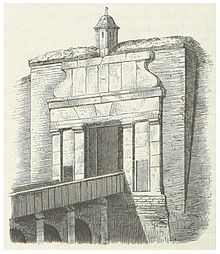Room gate

The Stubentor (formerly also written Stubenthor ) is a former city gate of Vienna .
history
The history of the gate went through at least three architectural phases. The oldest parlor gate consisted of the gate system, a built-in kennel and "black tower" around 1200 . With its gate tower, it was part of the oldest Viennese city wall , built between 1195 and 1250 .
Until the first Turkish siege , in 1529, the Wolfgang chapel stood in front of the Stubentor in the area of "Scheffstrasse", in the area of today's Biberstrasse . This was the first pastoral care center for the people who lived “among the white tanners”. The chapel was destroyed during the 1st Turkish siege.
After the first Turkish siege, it was rebuilt in the Renaissance style from 1555–1566 into a 25 m long box gate with a bell tower . The city wall withstood the second Turkish siege of 1683. In 1831 the gate was given a classical facade. The demolition of the wall up to today's Palais Coburg took place between April 9 and September 19, 1862. At the site of the former parlor gate, the Dr.-Karl-Lueger-Platz was built in the planned street grid of the Vienna Ringstrasse .
The system excavated 1985–1987 in the course of the construction of the U3 subway line and the station of the same name shows part of the Renaissance wall, the black tower (color black) and the floor plan of the gate built in 1555–1566 are reproduced in the pavement.
On March 10, 1528, Balthasar Hubmaier was executed in front of the parlor gate . A black metal plaque on the remains of the wall commemorates his death and his thoughts with the words:
- Dr. Balthasar Hubmaier
- Burned as an Baptist in front of the Stubentor on March 10, 1528
- Founder of the religious concept of tolerance
- "Christ did not come
- that he slaughter, murder and burn "
- (From "Of Heretics and Their Burners")
- The Christians of this city
Numerous funeral processions went through the Stubentor in the direction of the Sankt Marxer Friedhof during the 18th and 19th centuries . At that time it was customary for the mourners to accompany the funeral procession no more than to the city limits. With the composer Wolfgang Amadeus Mozart , one of the most famous former residents of Vienna left the city for good in the evening hours of December 6, 1791, the day before his funeral. The funeral procession broke up as usual at the parlor gate and in the dark no one accompanied the composer's corpse.
In front of the Stubentor underground station on the U3 line and inside, the remains of the city wall at the former Stubentor and a small exhibition about the Stubentor can be viewed.
Individual evidence
- ↑ Peter Scheuchel: Sacred places - saints and orders. The Vienna suburbs 2 to 9 . 1st edition. Studienverlag, Vienna 2013, ISBN 978-3-7065-5247-9 .
- ↑ see Czeike Felix: Historisches Lexikon Wien. Bd. 5 1997. S. 386 and Walter Hummelberger, Kurt Peball: The fortifications of Vienna.
literature
- Walter Hummelberger, Kurt Peball: The fortifications of Vienna . Paul Zsolnay Verlag, Vienna / Hamburg 1974.
- Wilhelm Kisch: The old streets and squares of Vienna and their historically interesting houses . M. Gottlieb's publishing house, Vienna 1883.
Web links
Coordinates: 48 ° 12 '27.3 " N , 16 ° 22' 44.3" E


